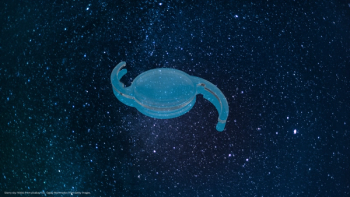
Toric ICL to correct ametropia in crosslinked keratoconic eyes
A study evaluating the safety and efficacy of Toric ICL implanted to treat ametropia in stable keratoconic eyes after CXL
Keratoconus often has a significant negative effect on quality of life as a result of the progressive induced myopia and astigmatism. The currently available treatment options are diverse. The corneal collagen crosslinking (CXL) proved to be the most encouraging modality to stop the progression of the disease.
Collagen crosslinking using riboflavin and UV light is now established as a minimally invasive procedure to stabilize or slow the progression of keratoconus. The increase in the corneal stiffness, flattening of the keratometric values along with symmetry index changes induced by this modality has its effect on the improvement of both uncorrected and best corrected visual acuity in those patients. The improvement is usually manifested by central shifting of the cone leading to a 'refractable' eye (i.e., a stable refraction in form of a sphere and cylinder that could result in satisfactory spectacle-corrected visual acuity). The improvement is usually significant in the first 6 months following the procedure and tends to stabilize thereafter. Central shift of the cone, along with obtaining a stable refraction, is considered to be 'the ultimate goal' of the CXL in keratoconus.
Addressing the correction of the sphere and cylinder in keratoconic eyes after stabilization of the cornea remains a debatable issue. Especially as patients usually ask for refractive correction hoping to enjoy a spectacle-free life.
Inclusion criteria
The study included 16 eyes (10 patients: 7 females and 3 males), their mean age was 25.6 ± 4.1 (21–33). The mean cycloplegic (objective) refraction was: Sphere: -7.62 ± 4.66 D (-2.00 to -16.00), Cylinder: -5.23 ± 1.67 D (-2.75 to -8.00) and the mean cycloplegic spherical equivalent was -10.24 ± 4.35 D (-4.75 to -18.50); whereas the mean subjective refraction was: Sphere: -5.42 ± 4.45 D (0.00 to -14.50), cylinder: -4.34 ± 1.62 D (-2.00 to -7.50) with a mean manifest spherical equivalent of -7.61 ± 4.10 (-2.25 to -15.75). The mean best spectacle-corrected visual acuity prior to ICL implantation was 0.63 ± 0.14 (0.4–0.8).
Newsletter
Get the essential updates shaping the future of pharma manufacturing and compliance—subscribe today to Pharmaceutical Technology and never miss a breakthrough.









































